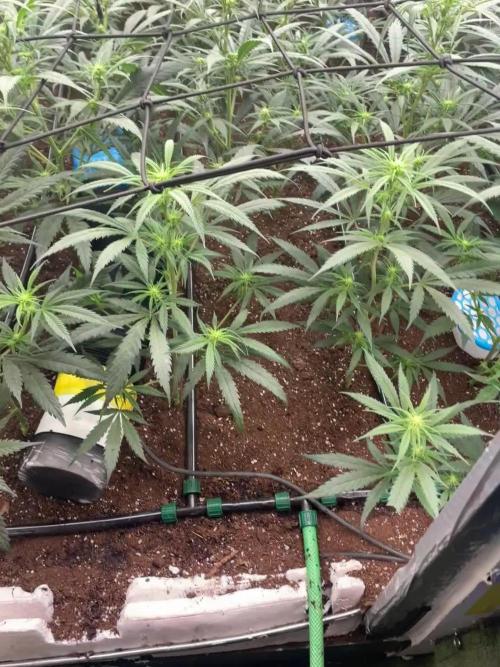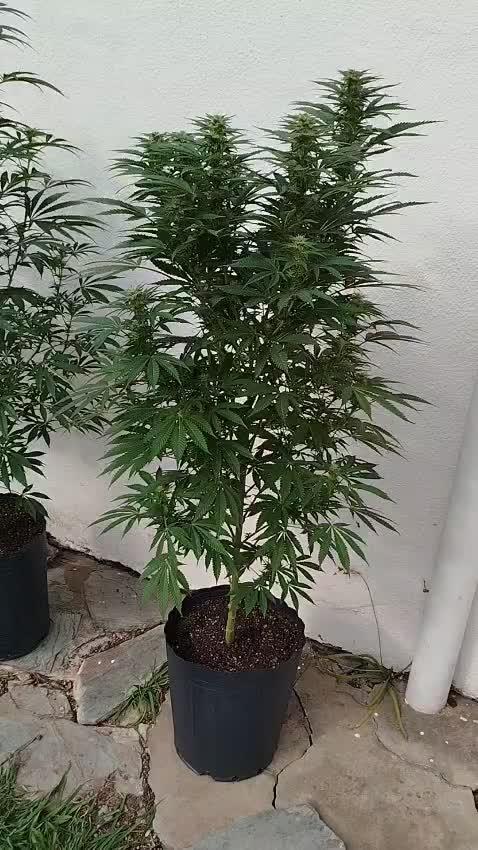The Grow Awards 2026 🏆 































Likes
6
Share


@carlitoshaze44
Follow
Así es como empezamos la tercera semana,seguimos con humedad alta pero la vamos controlando..
Estos días da buen tiempo la humedad en la calle será mucho más baja así podré meter aire sin tanta humedad..
De momento todo bien en el cultivo ningún problema hasta la fecha.
Ya podéis ver,y comentar sobre algo que veáis que yo no!
Como dicen! Ven veinte ojos mejor que dos!
🖖
Día 12
Último fungicida prevención mutritis,hongos
humedad.
Primer riego foliar hormonas producción de flores.
🌹
Día 13
Nada en especial solo observar si veo algún cambio tras las hormonas,aún no veo grandes observaciones fuera de lo natural del paso de los días.
En el día de mañana por lo que me recomendó el fabricante se verán los resultados a la vista!
Comentar que seguimos con la iluminación al 100x100 de capacidad
Marshydro sp3000 x2
Hero led Ignator t720
Yxo led 60w ir+un espectro completo
En la siguiente semana me llega el nuevo driver de philips para poder conectar la lámpara de IR que pude adquirir a Yxo nuevamente! Lampara led espectro completo + IR 70w .
Me vendrá muy bien para el pequeño espacio de la puerta que necesita más iluminación para poder desarrollar bien esas dos plantas,de la entrada.
La humedad fue cosa del pasado.
Evite el uso de desumificador eléctrico añadiendo varios de sales,deciros que funcionan muy bien no dan un control exacto pero mantienen una humedad interior estable para todo el periodo de floración!
50% de humedad lo demuestra!
Hoy añadi un poco más de sustrato. 110 litros exactamente sobre la cama de cultivo que tenía de topcrop con humus de lombriz,tierra diatomeas y alimentada con npk.
Después de eso tengo en mi cama de cultivo 810 litros de sustrato para mis 44haze. 💐
Saludos
Día 14
Anulado el intractor,ya que el propio extractor mete aire fresco por las rendijas de ventilación..
En lo largo de la noche iré viendo el resultado en datos..
Ya coloque los soportes para la nueva iluminación que en estos días llega su driver de sustitución
E visto que algunas plantas en estos dos días están en 67-70cm..
Ya colocado el sistema de riego para evitar más pisadas en el cultivo ya que algunas se realentizaron por pisar encima de sus raíces..
Le e metido una pequeña poda de bajos para airear más la zonas bajas del cultivo.
Pequeño riego de folacion con remedio de agua azúcar para dos que estaban más estresadas.
Día 15
Hoy era día de regar pero el sustrato aún parece húmedo en gran proporción aplazare el riego.
Día 16
Hoy me acerqué a ver las niñas en caso de que necesitaran algo..
Se ve todo correcto parece que no tienen mucha sed.. llevamos todo el día de alta humedad y lluvia en el exterior..
Las dejaré hoy sin riego también.
El sustrato está bien alimentado.
Mañana seguramente se presente el armario con una plantación pidiendo agua a gritos!! Jejeje.. así comerán con más ganas!,veremos qué tal..
Dia 17
Perfecto,las plantas se han mantenido muy bien para estar el sustrato ,prácticamente casi seco..
Se le aplicaron 32litros a la cama de sustrato con el riego de goteo
Y la humedad se ha mantenido bastante bien .
Una vez termine el riego la temperatura en el armario cayó considerablemente,llegando este a 16 grados.
Una vez se cierra todo vuelve a sus parámetros controlados de 23/24 grados.
Likes
Comments
Share


@FarmZOG
Follow
Day 75 to the big one, the other one nobody knows
we got to keep vegging til my room ready FFS
Beautiful root
Processing
Likes
22
Share


@DankBudz
Follow
Just got a remo kit.
Goin to start adding astroflower, kelp and remo bloom this week.
Dropped humidity to 45.
Likes
17
Share


@cheech87
Follow
Das Wachstum hat plötzlich Fahrt aufgenommen – diese Woche ist sie regelrecht explodiert. Und der Geruch! Ohne sie anzufassen, stinkt sie wie verrückt, aber eher auf eine würzige Art. Sie hat sehr lange Äste, was zu Beginn langsam war, hat sie nun alle anderen überholt.
Likes
5
Share


@Mrs_Larimar
Follow
2022-09-13
The Mimosa Purple Kush doing well
I think iam going to Harvest them in the next Days
Trichomes are milky, Plants are fading
Here is the Code for my Nutrients:
https://greenbuzzliquids.com/en/shop/
Code: mrs_larimar
xxxxxxxxxxxxxxxxxxxxxxxxxxxxxxxxxxxxxxxxxxxxxxxxxxxxxxxxxxxxxxxxxxxx
Mimosa Purple Kush Autoflower is a fruity sequel to our popular Purple OG Kush Feminized.
This new Mimosa Purple Autoflower has Purple OG Kush, Mimosa and
OG Kush Automatic as its ancestors making it a true recommendation for every Kush lover.
It’s not just a super nice strain but also great eye-candy due to the nice purple and blue hues.
Because it’s an autoflower strain, Mimosa Purple Kush can be grown in any climate and you’ve got a
harvestable plant after just 10 to 12 weeks after germination
The Mimosa Purple Kush Autoflower is indica dominant and therefore an ideal strain to grow on a balcony.
Because they stay compact if you grow them in a pot (+/- 60cm) then you don’t have to worry about them becoming
too large and on open ground they won’t be able to grow past 70 to 90 cm.
For an automatic Mimosa Purple Kush has a very high amount of THC of 18 to even 20%!
This guarantees a very relaxing high that won’t disappoint even veteran Kush smokers.
Likes
Comments
Share


@Danger_Mouse
Follow
There are two clearly differentiated phenotypes, but they are all beautiful plants.
Likes
26
Share


@Nistnov
Follow
I did partily harvest the Special Queen the microscope shows some orange/brown trichomes they are not enough to call her ready to harvest but just like with the Painkiller im scared of bud rot and next week will be raining non stop again so saftey first thats also the reason why i removed almost all the leaves, to improve airflow.
Honey Cream receives a good amount of fertilizer not sure if shes able to use it all since its getting cold and the sun is almost never shining.
I water with a concentrated solution because the ground is already soaking wet.
I guess i'll harvest the rest of the special queen this coming week.
Likes
2
Share


@grungedetox
Follow
Moved them to my main grow tent, then i transplanted the girls, gave them more fertilizer.
I topped phenos 1,2,4 a second time. Pheno 3 the slowest to develop not gonna do it again with her.
Pheno 4 is kind my favorite at the moment with better lower branches.
I also started LST on them.
They are really resillent with heat 💪🏻 it's been really hot where i lived and i don't have air conditioner unfortunally
Likes
6
Share


@Plantinator
Follow
I feed her with full strength of nutes in every 4 days. The leaves are much healthier, so this is the way to go.
The smell is lacking which is weird, but hopefully the end product will be fine.
Likes
94
Share


@DogDoctorOfficial
Follow
Discount Codes so you can save big on your next check out 💚💚💚
Kannabia - DOGDOCTOR 30% off
SeedsmanSeeds - DOGDOCTOR 10% off
CannaKan- DOGDOCTOR 15% off
terpyz.eu - DOCTOR 15% off
Fast Buds - DOGDOCT 15% off
As always thank you all for stopping by, for the love and for it all , this journey of mine wold just not be the same without you guys, the love and support is very much appreciated and i fell honored and so joyful with you all in my life 🙏
With true love comes happiness 💚🙏 Always believe in your self and always do things expecting nothing and with an open heart , be a giver and the universe will give back to you in ways you could not even imagine so 💚
Friendly reminder all you see here is pure research and for educational purposes only
Growers Love to you all 💚💚💚
Processing
Likes
14
Share


@Dre25
Follow
How they looking Growers!?! Saw white tips developing on my babies and I just flush them last week to fix the problem. They bounce back and Looking Beautiful 😭. Going to feed them tomorrow back to the nutrients.
Northern on the left, Amnesia in mid, purple lemonade on the right. Happy Growing and Be Safe!
Likes
14
Share


@ConspiracyFly
Follow
First I want to thank everyone who participated in last week's call for help especially GrowingGrannie and gottagrowsometime.
I made some changes starting with the distance of the LED, I did a defoliation reduced the Bio-Grow kept the Top Max and the Bio-Bloom added Calmag, Pandora powder mycoterra. BAC Frooting Power and ashes.
The downside I have is the humidity which stays at 70% even with the dehumidifier.
0,2 Bio-Grow
0,4 Top Max
0,4 Bio-Bloom
1,4 Calmag
1.5 gr Pandora Powder MYCOTERRA
3 gr de BAC Frooting Power
5 Tablespoons of ash
See you next week
Likes
7
Share


@Krissci
Follow
Haven't done much with this...
Shee look lovely..
All others done..just this strain left..
Onlyaugar water going forward
Likes
51
Share


@Dunk_Junk
Follow
So it seems like she's only grown a tiny amount in height this week but she's bushed out quite a lot. 💪
Likes
37
Share


@Gardener_of_Goodness
Follow
Well this was the last week! Had to chop her for various reasons but she’s pretty much done!
I will let the pics and videos do the talking!
I will update in 7 days with details of the harvest weights etc 😎
Likes
13
Share


@Dynamis
Follow
So this was my First Grow ! I am happy with the results- yes it didn’t yield alot only 40grams (1 plant). The buds arent so dense maybe cause of the strain or maybe the light - the overall color of the flowers is very stunning. The purple hue is simply special and unique. During the grow the temperature was getting too high sometimes reaching 30 celcius :/ this could be the result that affected the yield - in this grow I didn’t gave the plant alot of nutrients since I didn’t want to over feed and ruin my first grow.
Also during drying I decided to switch on my dehumidifier and caused the temperature in my room to increase around 27 celcius and humidity down to 45% ( yes its alot ). And so it caused the buds to dry quickly ( yes its bad ) another step i Did is Curing , there is a picture of the jar. I am keeping the humidity in the jar around 55% to 65% keeping it in a dark place. And so Yes - For sure there is room for improvement. Overall i enjoyed growing this strain and definitely i will be growing it again in the future. 💜💨





























